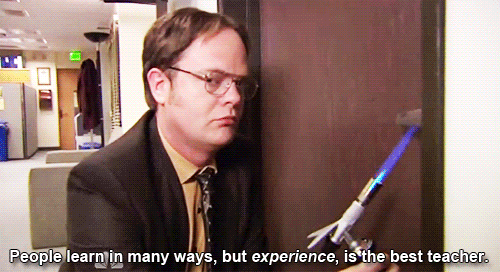
FIRE!
If you’ve ever seen the episode of The Office where Dwight sets the office on fire in order to demonstrate fire safety, you’ve seen Legitimate Peripheral Participation in action. For those who haven’t seen it, here’s a quick summary. Dwight, as safety officer, fails to effectively teach his coworkers about emergency protocol through a PowerPoint presentation, complaining that power points are boring and that no one can learn from them. So he sets the office on fire, blocks exits, and creates a worst-case scenario emergency in order to teach his coworkers how to escape.
Dwight’s methods are an example of what Wenger’s definition of learning that is situated in real life experiences. Wenger defines situated learning as a perspective that places emphasis on a “comprehensive understanding involving the whole person, rather than ‘receiving’ a body of factual knowledge” (Kindle, loc. 328). In other words, “People learn in many ways, but experience is the best teacher” (Dwight Schrute). We can see this played out in Dwight’s “fire drill” during which each individual was wholly involved in the activity. There was no room for bullet points and slides; it was a 100% active, engaged learning session.
Wenger defines Legitimate Peripheral Participation as “the process by which a newcomer becomes part of a community of practice.” In the instance of this Office episode, Dwight seeks to bring his coworkers into the community of practice of fire safety. While the employees rush around in a panic, climbing into the ceiling and battering doors down with a photocopier machine, Dwight remains a calm coach, guiding them through safety procedures (even though no one pays attention to him). We can see this as a hyperbolic example of traditional education methods and assignments which do not prepare students to perform in the real world, just as Dwight’s PowerPoint presentation did not prepare his coworkers to escape a fire.
Students need to be thrown into a burning building (a real, meaningful situation) in order to learn how to handle that situation. With only theory and no lived experience, students will gracelessly battering-ram their way through five-paragraph essays and never learn how to employ writing skills for “real-life” tasks. Legitimate Peripheral Participation in action is not always pretty. It can be chaotic and confusing, but it gives students the opportunity to learn what to do and what not to do by trying, failing, and eventually becoming part of a “community of practice.” Through all of the clumsy mistakes, I’m sure the characters in The Office learned more from participating than they did from the dull PowerPoint.
Wenger emphasizes that LPP is not a new teaching method, but a framework for understanding how people learn. Students will learn to write by actually writing, not doing practice exercises. While setting fire to a building may not be the best way to teach emergency procedures, the scenario does demonstrate the concept that people learn best by participating in a social context rather than being isolated from the world by a wall of scantrons and textbooks.
One Reply to “FIRE!”
Oh my goodness!! I loved that episode of The Office so this is a really good and entertaining example of LPP. I have always been one for learning in action so to speak. I will have to watch that episode again. Though I am not sure i want to be thrown into a burning building to learn how to escape a fire, but with any other thing that could involve possible future work, I think that this is a really good way to learn how to do whatever thing we are attempting to learn.